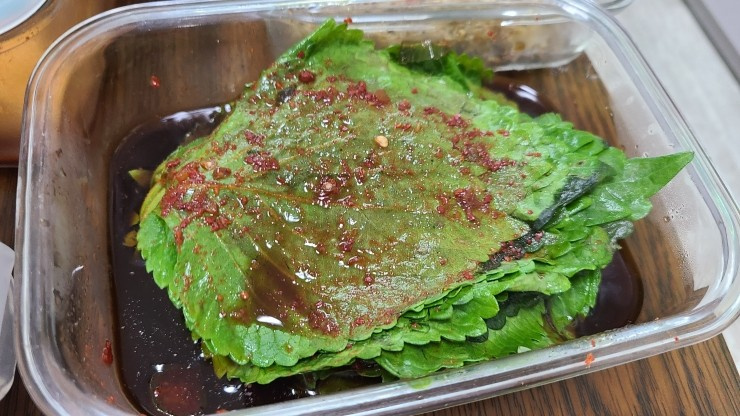Aromatic Perilla Leaf Jangajji (Pickled Perilla Leaves)
This is a recipe for Perilla Leaf Jangajji, a delicious side dish made with fresh perilla leaves. Its fragrant aroma and savory sauce make it a must-have on your dining table.

Perilla leaves are essential when enjoying grilled meats! This Jangajji recipe elevates their natural fragrance into a delightful condiment. It’s perfect for whetting your appetite and is a fantastic accompaniment to any meal. The flavor deepens with every day it ages in the refrigerator.
Main Ingredients- 2 packs of fresh perilla leaves (approx. 40-50 leaves)
Pickling Sauce- 10 Tbsp soy sauce
- 2 Tbsp plum extract (maesilcheong)
- 2 Tbsp red pepper flakes (gochugaru)
- 1 Tbsp minced garlic
- 3 Tbsp oligosaccharide
- 1 green onion (or 1 stalk of scallion)
- 3 chili peppers (green or red)
- 10 Tbsp soy sauce
- 2 Tbsp plum extract (maesilcheong)
- 2 Tbsp red pepper flakes (gochugaru)
- 1 Tbsp minced garlic
- 3 Tbsp oligosaccharide
- 1 green onion (or 1 stalk of scallion)
- 3 chili peppers (green or red)
Cooking Instructions
Step 1
Prepare the two packs of fresh perilla leaves. Instead of rinsing them immediately, soak them in a basin with 1 liter of water and 1 tablespoon of vinegar for about 3 minutes. This helps remove pesticides and impurities. Afterwards, gently rinse them under running water and drain thoroughly in a colander. Ensuring they are completely dry prevents the sauce from becoming diluted and the leaves from becoming mushy.

Step 2
Now, let’s make the delicious pickling sauce! Start by pouring 10 tablespoons of soy sauce into a bowl deep enough to mix.

Step 3
Add 2 tablespoons of plum extract to the soy sauce. This adds sweetness and depth. If you don’t have plum extract, you can substitute it with sugar or another liquid sweetener, but plum extract provides a unique subtle sweetness and aroma.

Step 4
For a touch of spiciness and vibrant color, add 2 tablespoons of red pepper flakes (gochugaru). If you prefer a milder taste, feel free to adjust the amount.

Step 5
Add 1 tablespoon of minced garlic, the key to savory flavor and aroma. Freshly minced garlic will impart a much richer scent.

Step 6
Incorporate 3 tablespoons of oligosaccharide for a glossy finish and smooth sweetness. Corn syrup or sugar can also be used as alternatives.

Step 7
Finely chop 1 green onion or scallion and add it to the mixture. The mild pungency of the onion complements the sauce, cuts through richness, and enhances the overall flavor.

Step 8
Add 3 chopped chili peppers for an extra kick and visual appeal. Using Korean green chilies (cheongyang) will add heat, while red chilies will contribute to the savory flavor and color. Remove the seeds before chopping. Adjust the quantity to your preference.

Step 9
Now, use a whisk or spoon to thoroughly combine all the sauce ingredients. Stir until the soy sauce base is smooth and well-integrated, with no lumps.

Step 10
Carefully layer the thoroughly dried perilla leaves into a clean container (a glass jar or airtight container is recommended).

Step 11
As you layer the perilla leaves, spread a moderate amount of the prepared sauce evenly over each leaf. Coating each leaf thoroughly ensures that the seasoning is well-distributed and results in a delicious Jangajji. Pay attention to coating the stems as well, allowing the flavor to penetrate.

Step 12
Once the container is filled, secure the lid and place it in the refrigerator. Allow it to mature for at least one day. The perilla leaves will soften, and the sauce will infuse, making them ready to eat. For an even richer flavor, wait 2-3 days before enjoying.

Step 13
Your aromatic and delicious Perilla Leaf Jangajji is complete! It’s a perfect side dish for rice or a delightful accompaniment to grilled meats.




